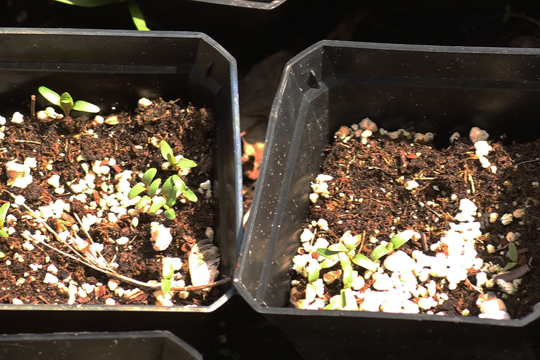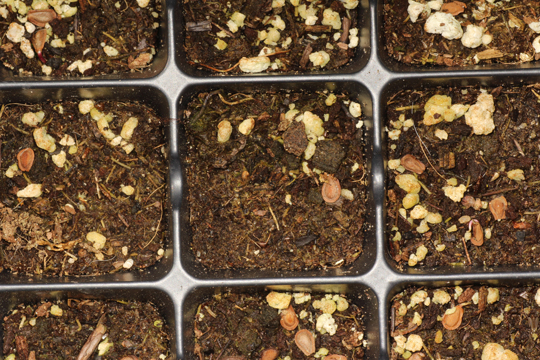Growing plants from seed
In a regular nursery the growers often keep the plant through at least one season so that you get instant gratification with plants. In fact, they prefer to sell the plants as they are coming into flower because they know you are more likely to buy a plant that is in the process of flowering. You pay more for this level of service. With native plant operations, the plants are often sold in the first season of growth and you may still have to wait a year or two or more for flowering to occur.
Gardeners grow plants from seeds for the following reasons:
a) They have a large plot and need lots of individual plants to fill in the space. It is cheaper to start from seed.
b) They are unable to buy the plant locally, but can easily obtain the seeds online.
c) It is fun to grow plants from seed.
You have a few choices for seed treatment:
i) You can simply sew the seed on the ground. In this case, I would use a lot more seed than you need and would rake the surface lightly before patting the seed down to improve contact between the seed and the soil.
ii) You can plant the seeds in pots in December and leave the pots outside all winter. The freeze thaw cycles will cause the seed to germinate in the spring when the temperature rises.
iii) You can replicate the freeze/thaw cycle by placing your seed packet in a plastic sandwich bag. Each day, move the bag from the freezer to the fridge and then back to the freezer on the following day. Do this for at least 8 consecutive days in mid-spring. Some people prefer to place the seeds in some soil-less mix with some moisture in a plastic sandwich bag, but I have not tested whether this is better or worse. Out of the methods listed, this is the easiest.
Here is what you need for planting seeds in pots:
Small plastic pots which can be bought. Commercial nurseries often will take old pots back so you might be able to get a free supply of these. Clean any recycled pots with mild solution of bleach (1 part bleach to 10 parts water).
Soilless starter mix, which is a blend of vermiculite, perlite, peat moss and perhaps sand. The sphagnum peat moss is good at retaining water. Perlite is a porous rock that retains air and increases the macropores. Vermiculite is better than perlite at retaining water but not as good for providing drainage. Starter mixes often do not have much fertiliser in them so you may need to add fertiliser when your plants get going. If you use potting soil with actual soil in them, you may run into a damping off problem (see below). By using a soilless mix, you avoid the problem of having unwanted plant pathogens and pest while providing a well drained medium with plenty of aeration for your seedlings. It is worth noting that sphagnum moss has to be mined from bogs which is an unsustainable practice that has resulted in destruction of much lowland bog habitat. You might want to consider starter mixes with an alternative ingredient if they are available.
| |
 |
|
| |
These pots are 4 inches wide which is the standard size to use for most plants to grow through the season. They are filled with a soil less mixture. |
|
Seedlings are prone to attack from various fungi that either damage the roots or which may cause a visible mould to start growing at the base of the plant. Once the damage is done, it is almost impossible to correct. If you want to avoid this problem, you should grow your seeds outside. Inside your house, the humidity is higher, which promotes fungal growth and the fungal spores that cause damping off are more likely to be in the air supply. Often gardeners want to start their seeds early so planting indoors is the only option. Leave space between the plants for air to circulate and plant them somewhere in the house where air circulation is higher. Never pour water onto the plants. Dip the pots in water until you can feel that they are heavier. Under no circumstances, should you cover your native plant seedlings with a plastic lid because this will allow the humidity to build up to levels that favour damping off.
| |
 |
|
| |
These starter trays have small amounts of soil in them. They are not designed to keep seedlings in for the whole season as the roots will be too confined to allow the maximum amount of growth to take place. This tray has milkweed seeds which have been pushed firmly onto the soil surface to ensure good contact. |
|
You have a few choices for starting in soilless mix. Growers needing large numbers on individual plants should plant the seeds in one large tray. When the seedlings appear, the larger and healthier specimens can be carefully disentangled from surrounding seedlings and planted in their own pot. If you just want a few specimens, then put 3 or 4 seeds in each pot and when the seedlings appear, pull out the ones you don't want. If you are going to plant the seedlings fairly early, then they do not need too much space for root growth. You can use the trays that contain spaces for small amounts of soil. If you are planning on culturing your seedlings all summer, which is my preference, then you need a 4 inch pot to allow for healthy root growth during the first season.
| |
 |
|
| |
It is tempting to leave every specimen to grow but because they are so close together, these seedlings will compete with each other for nutrients and their roots will become entangled. Seedlings this close together should be replanted separately or you can just pull the weakest specimens out. |
|
Squirrels love to investigate anything new that is put out in the garden so you should always expect to lose a few pots to them, but take a look at the picture below to see if you can spot something a little bit more unusual.



